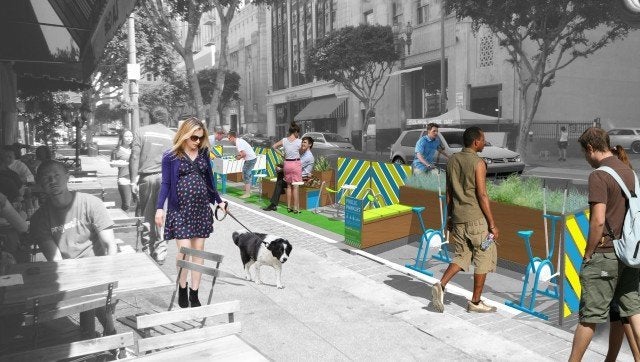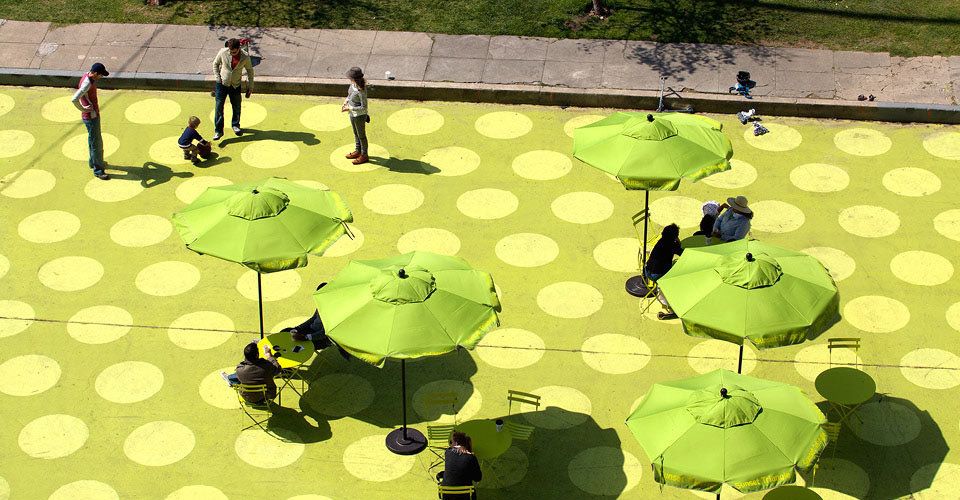
“Nobody Walks In LA,” the refrain from a popular tune from the 1980s, may as well be the city’s anthem. But Margot Ocañas, just hired as the City of Los Angeles' first-ever "pedestrian coordinator," plans to change that.
Ocañas, 48, walked to school and dance lessons as a young girl in Pennsylvania. Later, as an adult living in Southeast Asia, Germany and New York City, she enjoyed the human interaction and economical advantages of life on foot.
But when Ocañas moved to Los Angeles 10 years ago, she quickly adopted the "LA attitude," she told The Huffington Post. She subscribed to the belief that driving was her only possible mode of transportation. When her two children wanted to ride bikes recreationally, she found herself packing up their bikes in her car and driving 45 minutes to the safer sidewalks of Santa Monica.
But then the inner pedestrian in her awoke. She became determined to find a way for her family to be able to safely bike in their own mid-city neighborhood, just south of the Los Angeles County Museum of Art.
Her solution: to take over a street completely. After clearing away a few municipal roadblocks, Ocañas successfully coordinated a block party with about 200 participants. The kids biked and walked on the pavement, and the parents met each other -- many for the first time -- on the sidewalks.
In fact, a conversation that she had at the block party led to her being hired as a policy analyst for the Los Angeles County Department of Public Health. It was the first public sector job for Ocañas, who had previously worked in marketing, financial consulting and independent film production.
Meanwhile, she began leaving her car at home more often, whether it was walking with her son to his karate lessons or biking with her kids to the store when they wanted to make cookies. She even coordinated bike carpooling to her kids' school. Thanks to her, parents in her neighborhood now take turns chaperoning a "bike train" of a dozen or so children to and from school.
But this born-again pedestrian was about to take a much bigger step. In early 2012, she was a driving force behind LA's conversion of 11,000 square feet of street and parking spots in the Silverlake neighborhood into an unprecedented, polka-dotted, neon-green "residual roadway plaza" -- in effect, a small bike and pedestrian park.
"The idea is to re-capture public streets for people. Over 60 percent of downtown LA, for example, is given to streets and parking lots," said the city's planning commission president Bill Roschen, who initiated the project.
Roschen praised Ocañas' role in what is informally known as the “Polka Dot Plaza.”
“She wasn't from the extensive city bureaucracy,” Roschen told HuffPost. “She wasn't afraid to talk between departments to explore how to make this happen quickly."
The entire endeavor -- which, aside from the painted polka dots, involved setting up planters, tables and umbrellas -- was completed in only four months. The plaza cost $25,000, a price touted as reasonable compared to traditional parks. That cost is expected to be even less for future plazas.
Still, at the grand opening of the plaza in March, a naysayer in the audience complained about the loss of parking spots. And others have complained about the neon green polka dots.
But the plaza is a one-year pilot program. It can be changed and even removed altogether based on feedback. "Normally, it’s a very long, drawn out process to get to a traditional park or capital investment project, such as expanding a sidewalk," Ocañas said. "But expediency is key because when you physically get it out there, then the conversations really begin and the possibilities expand."
Now, as the city's newly appointed, first-ever pedestrian coordinator, Ocañas plans to put this model of expediency and community involvement together into a plan called "Streets for the People." The plan will provide a system through which Angelenos can request a plaza in their neighborhood, to be funded by neighborhood discretionary funds.
LA is a particularly opportune place for this, said Valerie Watson, an urban designer hired as assistant pedestrian coordinator to Ocañas. "We have so many miles of streets and interesting pockets of space to use. Park plazas are in heaven here," she said.
Through "Streets for the People," the city will also create other forms of "people space," including parklets, which are parking spaces turned into sidewalk extensions with furniture, as well as bike corrals, which are parking spaces used for bike parking. The idea is to make the streets as comfortable and safe as a living room.
Across the city, pedestrian safety is in desperate need of improvement. In Los Angeles, pedestrians accounted for about a third of all traffic fatalities, or nearly triple the national average of 11.4 percent, according to a recent study by the University of Michigan Transportation Research Institute.
Considering everyone from children walking to school to elderly people who have trouble making it across LA’s unusually wide streets in time for traffic lights, Ocañas plans to improve signaling, striping, crosswalks, signage and lighting.
By reengineering the pedestrian environment with improved amenities and safety, the hope is that more Angelenos will walk and bike. And that will improve individuals' health and decrease the city's congestion and pollution. It will also increase economic development on streets that gain foot traffic.
But Ocañas is also aware of the need to take on that "LA attitude" -- an emotional attachment to cars -- that she felt upon moving to the city. The most effective way to change attitudes, Ocañas said, is through experiences, not media or messaging. As an example, she pointed to CicLAvia, the event that shuts down more than seven miles of streets for thousands of cyclists and pedestrians. Like her block party and the Polka Dot Plaza, Ciclavia gives people a reason to spend time on the street.
“There's a visceral feel about the city that you would never be able to get if someone tried to explain this to you in a conference room,” Ocañas said. But once you’re in the middle of the street, a place you’ve never imagined being, she said, “you start to think and feel differently."
And at the speed at which Ocañas moves, Los Angeles can expect large strides forward soon.
Click through photos of Ocañas, Watson, the Polka Dot Plaza, parklets, Ciclavia and bike lanes in LA

